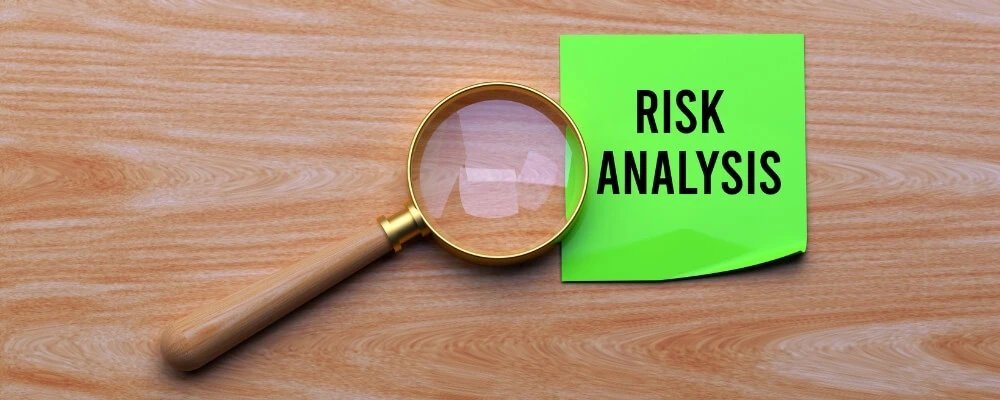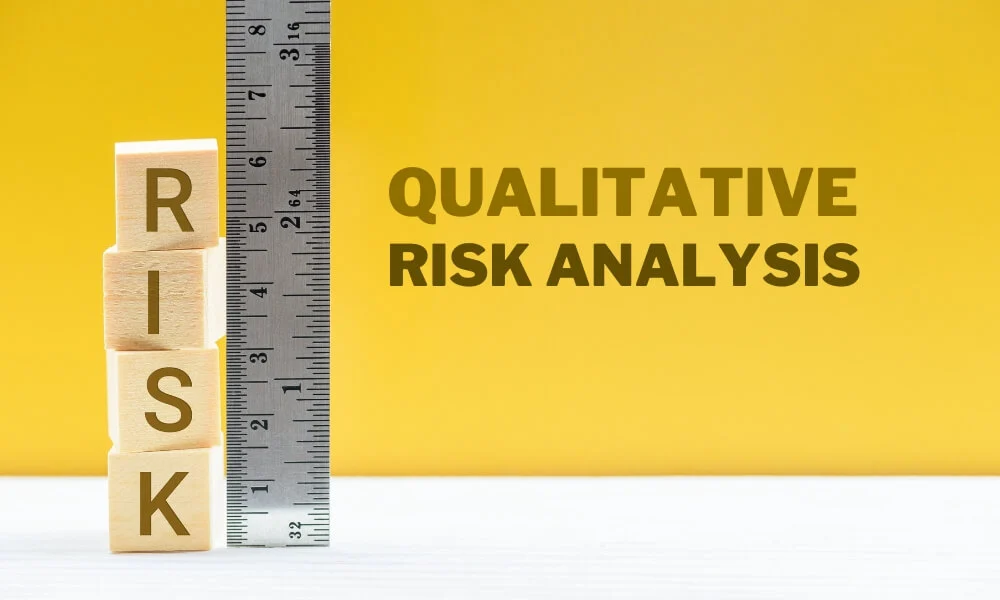In the ever-evolving landscape of business and project management, uncertainties can either be a roadblock or an opportunity, depending on how they’re approached. Qualitative Risk Analysis emerges as a beacon, illuminating these uncertainties and providing a roadmap to navigate them effectively. Whether you’re a seasoned project manager, a budding entrepreneur, or anyone striving to make informed decisions amidst potential challenges, understanding qualitative risk analysis is crucial.
In this blog, we’ll delve into its definition, explore the methodologies that underpin it, and walk you through its meticulous steps. Armed with this knowledge, you’ll be better equipped to transform risks from potential threats into opportunities, driving success in any venture you undertake. So, let’s embark on this journey and demystify the intricate world of qualitative risk analysis.
What is Qualitative Risk Analysis? Definition
Qualitative risk analysis is a method used to assess the potential threats and opportunities within a project or organization without relying on numerical metrics. Instead of using hard data or quantifiable measurements, it leverages subjective judgments, insights, and experiences to evaluate risks.
- Identification: The first step involves recognizing potential project or organization risks. This is typically done through brainstorming sessions, expert opinions, historical data, or stakeholder interviews. The risks identified can range from operational to financial, technological, or even regulatory.
- Analysis: Once the risks are identified, they are analyzed regarding their potential impact and likelihood of occurrence. This is often done using a rating scale, such as “low,” “medium”, or “high.” For example, a risk might be deemed to have a high likelihood of occurring but only a medium impact on the project.
- Evaluation: With the likelihood and impact assessed, the risks are then evaluated to determine their overall severity. Risks that are highly likely and highly impactful will be prioritized higher than those with a low likelihood and low impact.
- Prioritization: The evaluated risks are then prioritized. This helps the project manager or organization to focus resources on the most significant risks. By knowing which risks to address first, an organization can effectively allocate resources and implement strategies to mitigate those risks.
- Review and Monitoring: As a project progresses or circumstances within an organization change, it’s crucial to revisit the qualitative risk analysis. Some risks might become more or less likely, or their potential impacts could change. Continuous monitoring ensures that the organization remains prepared and can adjust its strategies as needed.
The advantage of qualitative risk analysis is its flexibility and speed. Since it doesn’t require specific numerical data, it can be conducted relatively quickly, making it especially useful in the early stages of a project or when there’s limited information available.
However, for more detailed risk management, especially in larger projects or complex situations, it may be supplemented or followed by quantitative risk analysis, which uses numerical values and statistical methods to provide a more precise risk assessment.

Qualitative Risk Analysis Methods
Qualitative risk analysis offers a holistic approach to understanding potential challenges and opportunities within a business landscape. It emphasizes non-numerical insights, primarily drawing upon expert opinions, historical data, and intuitive judgment. Let’s dive deeper into some of the prominent methods:
1. Delphi Method
The Delphi Method is a unique structured communication approach that draws strength from engaging a panel of experts. The essence of this method is to gain valuable insights and converge to a consensus on a particular topic. In practice, these experts individually respond to questions, particularly about potential risks in the context of risk analysis. Once their initial responses are gathered, they’re summarized and presented to the experts. This iterative feedback loop allows experts to reconsider their original answers in light of what others have said.
As this process continues, the varied opinions converge, leading to a more refined and collective agreement. A distinctive feature of the Delphi Method is its anonymity, ensuring experts do not have direct face-to-face interactions. This format minimizes potential biases, groupthink, or undue influence, paving the way for a more genuine and objective outcome.
2. Risk Probability and Impact Assessment
Understanding risks is about identifying them and discerning their potential magnitude and likelihood. As the name suggests, risk Probability and Impact Assessment evaluates risks on two fronts: the chance of them occurring and the consequences if they do manifest. Every recognized risk is gauged for its likelihood of happening, often classified as low, medium, or high. After this is evaluating the potential ramifications if the risk does pass, especially concerning pivotal project objectives like time, cost, quality, and resources.
The key advantage here is the dual assessment that offers decision-makers a clearer picture. By juxtaposing the likelihood and ramifications, they can better prioritize which risks warrant immediate attention and resources, ensuring a more proactive and strategic risk management approach.

3. Decision Tree Analysis
Decision Tree Analysis is a visual tool that encapsulates potential decision pathways and their subsequent outcomes. At its core, it’s a tree-like graph where each branch represents a choice and its subsequent result. As decisions branch out, various outcomes, which also might be associated with certain risks, are illustrated.
Alongside these outcomes, probabilities are ascribed, quantifying the likelihood of each outcome. This format becomes particularly invaluable for complex decision-making scenarios, where multiple variables and outcomes must be considered simultaneously. The graphical representation allows for a more intuitive understanding, ensuring that decision-makers can quickly ascertain the potential results of various choices, ensuring more informed and strategic decisions.
4. Bow Tie Analysis
A pictorial way of viewing risks, Bow Tie Analysis delves deep into the cause-effect relationships of specific risks. Envision a bow tie; the knot in the center represents a specific undesired event or risk. The left side of the bow tie lays out potential causes or triggers that could lead to this central risk event.
Conversely, the right side enumerates the likely consequences or outcomes if that event does transpire. This dual-sided analysis provides a panoramic view of risks from causative and consequential perspectives. The visual nature of this method facilitates easy comprehension. It allows stakeholders to craft targeted strategies to prevent the causes or mitigate the adverse effects, ensuring a holistic risk management approach.
5. SWOT Analysis
A cornerstone in strategic planning, SWOT Analysis offers a comprehensive look at a project or business’s internal and external environments. The acronym stands for Strengths, Weaknesses, Opportunities, and Threats. Strengths and Weaknesses dive into the internal dynamics of an organization, highlighting what it does best and where it might be lacking. On the other hand, Opportunities and Threats are externally oriented, spotlighting potential areas for growth and external challenges that might impede progress.
By juxtaposing these four elements, businesses can recognize their intrinsic capabilities and align them with the external environment. This alignment ensures they capitalize on opportunities using their strengths, buffer against threats by addressing weaknesses, and navigate the business landscape with agility and foresight.
These qualitative risk analysis methods can equip businesses and project managers with insights beyond mere numbers. They highlight the interconnected nature of risks, fostering a proactive risk management culture. Combined with quantitative methods, they provide a comprehensive risk overview, ensuring a more resilient approach to business challenges and project management.

How To Perform A Qualitative Risk Analysis
Qualitative risk analysis is a critical tool in assessing the uncertainties that can influence an organization’s ability to meet its objectives. Organizations can strategically navigate challenges and capitalize on opportunities by understanding and ranking these risks. Here’s a detailed breakdown of the process:
1. Risk Identification
Begin by cataloging potential risks that may impact the project’s goals. Consider this a brainstorming session where every possible uncertainty is considered, whether currently affecting the project or potentially arising.
To make this effective, consult team members, stakeholders, and historical data. Once the risks are identified, prioritize them based on their potential impact and likelihood. A well-structured list ensures that the most critical risks are addressed first, streamlining resource allocation.
2. Risk Assessment
After identification, dive deeper into each risk. The goal is to grasp its potential implications and how it aligns with other risks. A popular tool for this process is the risk register. It’s a dynamic document listing all identified risks, categorizing them, and ranking them based on their importance. You can efficiently allocate resources and strategies by systematically addressing the most significant risks in each category.
This phase often benefits from the expertise of a seasoned project manager or a quality assurance engineer, as they can guide the team in understanding the nuances of each risk. Even though not all risks can be entirely eradicated, the team can strategize to mitigate their impact or prepare for their occurrence.
3. Drafting a Risk Report
Documenting the findings is pivotal. A comprehensive risk report briefly summarizes each risk, its potential implications, and the planned action to address it. This report acts as a reference point, clarifying the risk landscape.
It should cover a risk’s nature, its assigned rating, potential responses, recommended action steps, and a timeline for these actions. Such documentation is invaluable for current project phases and can be a template for future endeavors.

4. Risk Response Implementation and Monitoring
Once you’ve outlined how to address each risk, it’s time to set those plans in motion. Swiftly implement risk responses and then observe their efficacy. By actively monitoring, you can gauge if the response alleviates the risk or if further adjustments are required. It’s a cycle of action, observation, and refinement until the risk is managed effectively.
5. Ongoing Risk Management
Risk management isn’t a one-off task. As the project progresses, new risks and existing ones may evolve. Consequently, the risk management plan needs regular reviews and updates to remain relevant.
Moreover, maintaining open communication channels ensures that all stakeholders are informed and prepared. By staying vigilant and fostering a proactive approach, teams can pivot when needed, ensuring project resilience and success.
Conclusion
In the intricate maze of project management and strategic decision-making, qualitative risk analysis stands out as both an art and a science. It quantifies uncertainties and offers a structured approach to transform potential threats into actionable insights. Professionals from various fields can harness this tool to ensure robust planning, effective resource allocation, and agile responses to unforeseen challenges by understanding its definition, methods, and steps.
As we conclude this exploration, it’s evident that mastering qualitative risk analysis is more than just a skill—it’s a cornerstone for any successful project or endeavor. Whether you’re at the helm of a massive project or at the inception of a new venture, leveraging this analysis will undeniably pave the way for informed decisions, streamlined processes, and enhanced outcomes. Embrace it, and steer your ventures toward success with confidence and precision.

